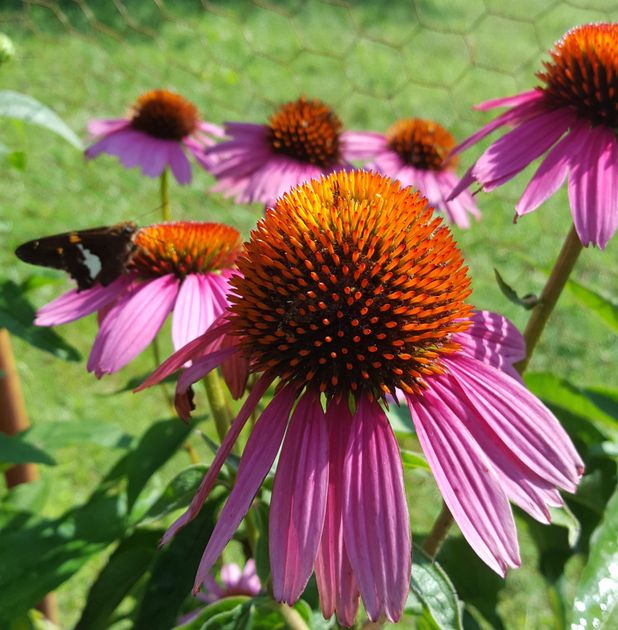
"Echinacea purpurea: Pharmacology, phytochemistry and analysis methods".
#Purple coneflower plant how to#
^ "Echinacea – How To Grow Purple Coneflower".Eastern Purple Coneflower ( Echinacea purpurea) ^ USDA Natural Resources Conservation Service."Echinacea Explosion - The Purple Coneflower Chronicles". ^ "RHS Plantfinder - Echinacea 'Elbrook' ".^ "RHS Plant Selector - Echinacea purpurea 'Ruby Giant' ".Southeastern Wildflowers: Your complete guide to plant communities, identification, and traditional uses. "Popularity, Diversity and Quality of Echinacea". ^ "2014 county distribution map of Echinacea purpurea".United States Department of Agriculture Natural Resources Conservation Service. ^ a b "Echinacea purpurea (L.) Moench (eastern purple coneflower)".^ a b c d "Echinacea purpurea - (L.)Moench"."Echinacea: Not always a purple coneflower". ^ a b "Eastern purple coneflower, Echinacea purpurea (Linnaeus) Moench, Methodus.^ The Plant List, Echinacea purpurea (L.) Moench.purpurea, followed by the flavonoid rutin. Nicotiflorin is the dominant flavonoid in E. Chemistry Įchinacea purpurea contains alkamides, caffeic acid derivatives, polysaccharides, and glycoproteins. Additionally, roots can be damaged and eaten by gophers. Slugs and rabbits will also eat the foliage when young, or shortly after emerging in the spring.

Seeds may be started indoors in advance of the growing season or outdoors after the growing season has started. Seed germination occurs best with daily temperature fluctuations or after stratification, which help to end dormancy. Cuttings of basal shoots in the spring may be rooted when treated with rooting hormones, such as IBA at 1000 ppm. Cuttings made from roots that are "pencil-sized" will develop into plants when started in late autumn or early winter. Clumps can be divided, or broken into smaller bunches, which is normally done in the spring or autumn. Useful vegetative techniques include division, root cuttings, and basal cuttings. Propagation Įchinacea purpurea is propagated either vegetatively or from seeds. The cultivars 'Ruby Giant' and Elton Knight='Elbrook' have gained the Royal Horticultural Society's Award of Garden Merit. It thrives in either dry or moist soil and can tolerate drought once established.

Numerous cultivars have been developed for flower quality and plant form. The flowers can also go into the composition of fresh bouquets. The fruit is an achene, sought after by birds.Įchinacea purpurea is grown as an ornamental plant in temperate regions.
#Purple coneflower plant full#
The plant prefers well-drained soils in full sun. The involucral bracts are linear to lanceolate. The tubular florets are hermaphrodite while the ligular florets are sterile. These are surrounded by a ring of pink or purple ligulate florets. The inflorescence is a capitulum, 7 to 15 cm in diameter, formed by a prominent domed central protuberance consisting of multiple small yellow florets. The alternate leaves, borne by a petiole from 0 to 17 cm, are oval to lanceolate, 5-30 x 5-12 cm the margin is tightened to toothed. It is pollinated by butterflies and bees. Its individual flowers (florets) within the flower head are hermaphroditic, having both male and female organs in each flower. Its cone-shaped flowering heads are usually, but not always, purple in the wild. Depending on the climate, it blooms throughout summer into autumn. Other names include: Broad-leaved purple coneflower, Eastern Purple Coneflower, Hedgehog Coneflower, Echinacea.Įchinacea purpurea is an herbaceous perennial up to 120 cm (47 in) tall by 25 cm (10 in) wide at maturity. The authors proposed to retain the names not to cause confusion among gardeners and herbalists.

discovered a misapplication of the name Echinacea purpurea (L.) Moench for the taxon correctly named Echinacea serotina (Nutt.) DC. Just two decades later, De Candolle raised him to the rank of species of the other genus Echinacea serotina (Nutt.) DC. In 1818, Thomas Nuttall describes a new variety that he named Rudbeckia purpurea var. Originally named Rudbeckia purpurea by Linnaeus in 1753 in Species plantarum 6, it was reclassified in 1794 by Conrad Moench, in a new genus named Echinacea purpurea (L.) Moench. The epithet purpurea means 'reddish-purple'. Echinacea is derived from Greek, meaning 'spiny one', in reference to the spiny sea urchins 'εχίνοι' which the ripe flower heads of species of this genus resemble.


 0 kommentar(er)
0 kommentar(er)
